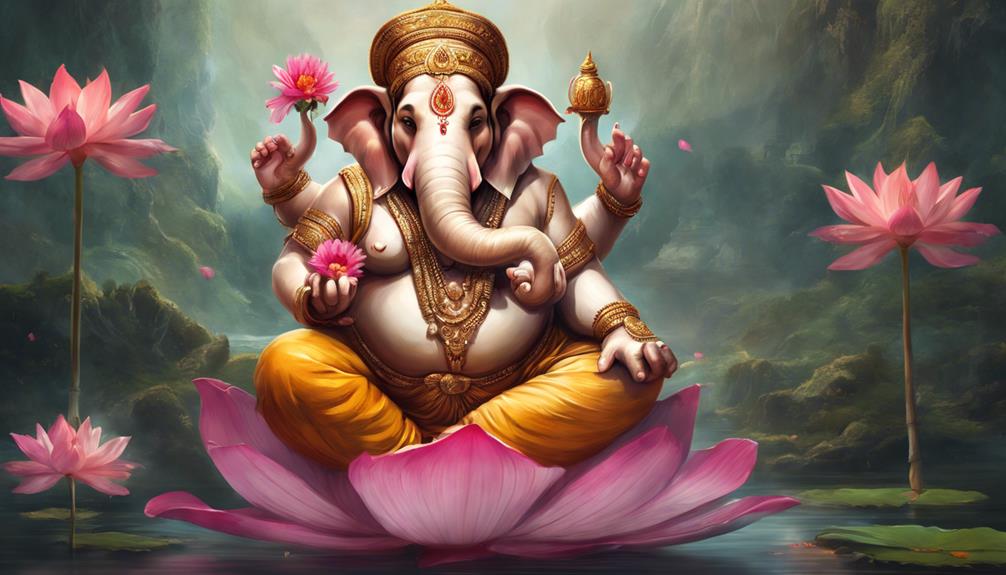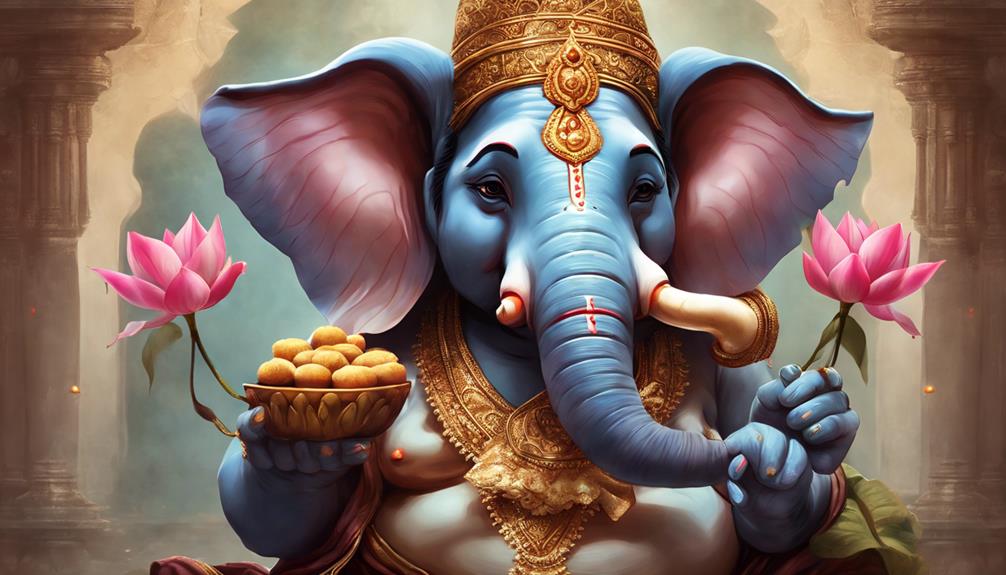The story of Lord Ganesha's birth is rooted in Hindu mythology, where maternal devotion plays a key role. Parvati, Ganesha's mother, crafted him from sandalwood paste out of maternal instinct, imbuing him with strength and wisdom. The elephant head symbolizes profound wisdom and divine power, making Ganesha a beloved deity associated with protection and prosperity. This significant creation story reveals the symbolic richness and divine origins of Lord Ganesha, hinting at deeper insights into Hindu mythology's intricate narratives.
Table of Contents
Key Takeaways
- Parvati creates Ganesha from sandalwood paste out of maternal love.
- Ganesha symbolizes wisdom, strength, and obstacle removal in Hindu mythology.
- Elephant head signifies intelligence and divine power in Ganesha's birth story.
- Maternal devotion and emotional bond central in Ganesha's birth and symbolism.
- Ganesha's birth celebrates familial relationships and divine origins.
Origin of Lord Ganesha
The birth of Lord Ganesha, also known as Ganapati, is a significant event in Hindu mythology that traces back to ancient times. Ganesha's creation is intertwined with the symbolic representation of an elephant and the significant maternal devotion of Goddess Parvati. In Hindu culture, elephants symbolize wisdom, strength, and remover of obstacles, qualities that are embodied by Lord Ganesha himself. The elephant head of Ganesha signifies wisdom and intelligence, encouraging his devotees to overcome obstacles with cleverness and thoughtfulness.
Maternal devotion plays a vital role in the birth of Lord Ganesha. According to the mythological tales, Goddess Parvati, Ganesha's mother, sculpted him from sandalwood paste and brought him to life with a mother's love and dedication. Her unwavering commitment and affection for her son highlight the deep bond between a mother and child, emphasizing the importance of maternal care and protection in Hindu traditions. This maternal love is a central theme in the stories surrounding the birth of Lord Ganesha, showcasing the eternal bond between a mother and her child in Hindu mythology.
Parvatis Creation of Ganesha
In the mythological tales surrounding Lord Ganesha's birth, Goddess Parvati skillfully crafted him from sandalwood paste, infusing him with life through her boundless love and dedication. Parvati's love for her son-to-be emanated from a deep maternal instinct, driving her to create a guardian unlike any other. With each delicate touch, she imbued Ganesha with qualities that would make him unique and powerful.
Parvati's maternal instinct guided her hands as she molded Ganesha's form, ensuring that he'd possess the strength and wisdom needed for the challenges ahead. Her unwavering dedication to her creation was evident in every detail, from the curve of his trunk to the positioning of his many arms.
Through Parvati's love and devotion, Ganesha emerged as a symbol of protection and prosperity, embodying the essence of a mother's unconditional care and a creator's boundless creativity. This act of divine craftsmanship laid the foundation for Ganesha's role as a beloved deity and a revered figure in Hindu mythology.
Shivas Return and the Obstacle

When Shiva returned to the abode, he encountered an unexpected obstacle – a young boy guarding Parvati.
This obstacle led to a confrontation between Shiva and the boy, resulting in a drastic turn of events.
The birth of Lord Ganesha is intricately linked to this moment of challenge and resolution in Hindu mythology.
Shivas Reunion Challenge
Upon Shiva's return, a formidable obstacle arose, testing the strength of his reunion challenge. After Parvati's creation of Ganesha, she appointed him as the guardian of their abode. When Shiva attempted to enter, Ganesha, following his mother's orders, blocked his path.
Enraged by this unforeseen challenge, Shiva's temper flared, leading to a fierce battle that ended with Ganesha losing his head. This clash between father and son marked a pivotal moment in their relationship, showcasing the intensity of Shiva's challenge and the unwavering commitment of Parvati's creation.
The reunion between Shiva and Parvati faced a significant hurdle, setting the stage for the birth of Lord Ganesha and the remarkable events that followed.
Ganeshs Birth Obstacle
After the intense battle between Shiva and Ganesha resulted in the loss of Ganesha's head, the birth of Lord Ganesha took an unexpected turn, revealing a significant obstacle in Shiva's return and the subsequent events that unfolded.
Despite Shiva's attempts to reunite with Parvati, the obstacle of Ganesha's head being severed by Shiva caused a dilemma. Parvati was devastated by the loss of her son and demanded that Ganesha be brought back to life.
In response to Parvati's anguish, the gods managed to find a divine solution by attaching the head of an elephant to Ganesha's body. This divine intervention led to the birth of Lord Ganesha, marking the beginning of a joyous birth celebration that continues to be commemorated with great fervor.
Ganeshas Elephant Head
In the depiction of Lord Ganesha, the elephant head symbolizes wisdom, intellect, and divine power. This unique feature of Lord Ganesha has deep symbolic significance rooted in ancient Hindu mythology. According to the myth, when Lord Shiva beheaded Lord Ganesha and later made amends by replacing his head with that of an elephant, it was more than just a physical transformation. The elephant head represents the ability to see beyond the spiritual domain, signifying profound wisdom and intellect that transcend ordinary human capabilities.
The elephant symbolism in Lord Ganesha's appearance highlights his divine origins and the extraordinary nature of his being. It serves as a reminder of the divine power he possesses, emphasizing his role as a remover of obstacles and a provider of knowledge and prosperity. The elephant head is a visual representation of Lord Ganesha's supreme wisdom and his ability to navigate the complexities of life with grace and intelligence, making him a revered deity in Hinduism.
Significance of Ganeshas Birth

Lord Ganesha's divine origins trace back to his birth from Goddess Parvati's thoughts and body. The symbolism in his birth story includes his creation by Parvati out of clay and his role as a remover of obstacles. His arrival not only signifies new beginnings but also highlights the intricate family dynamics among the divine beings.
Lord Ganesha's birth story is rich in symbolism and significance, providing insights into the divine order and the interconnected relationships among the deities. His unique origins and attributes make him a beloved figure in Hindu mythology and a source of inspiration for overcoming obstacles and seeking blessings for new endeavors.
Ganeshas Divine Origins
During a time of great turmoil and conflict among the gods, Lord Ganesha's divine origins emerged, marking a pivotal moment in Hindu mythology.
Ganesha, also known as Ganapati or Vinayaka, is believed to be the son of Lord Shiva and Goddess Parvati. The origin story of Ganesha varies, but one common tale recounts how Parvati created Ganesha out of sandalwood paste and breathed life into him, making him her guardian. This divine creation was meant to protect Parvati while she bathed.
Ganesha's birth symbolizes purity, protection, and auspicious beginnings. His unique appearance with an elephant head and a human body embodies wisdom, intelligence, and the ability to overcome obstacles.
Ganesh Chaturthi, the festival celebrating his birth, is observed with great fervor across India.
Symbolism in Birth
Symbolizing purity, protection, and auspicious beginnings, Lord Ganesha's birth story reveals profound layers of significance in Hindu mythology.
The symbolic representation of Ganesha's birth holds immense spiritual significance. When Goddess Parvati created Ganesha from the sandalwood paste she used for her bath and brought him to life, it symbolized the purity and divinity of his existence.
Ganesha being appointed as the guardian of the threshold by Shiva signifies his role in offering protection and removing obstacles.
His elephant head, acquired after a fierce battle with Shiva, represents wisdom, intelligence, and the ability to overcome challenges.
The birth of Lord Ganesha embodies the essence of new beginnings, safeguarding devotees, and the pursuit of knowledge in Hindu tradition.
Family Dynamics Explained
In understanding the significance of Lord Ganesha's birth in relation to family dynamics, one can unravel the intricate connections and roles within Hindu mythology. The parent-child dynamics between Lord Shiva and Goddess Parvati play an important role in shaping Ganesha's birth. Parvati's desire for a son led her to create Ganesha, highlighting the deep emotional bond between a parent and child.
Additionally, Ganesha's relationship with his brother, Lord Kartikeya, showcases the complexity of sibling rivalry. The tale of Ganesha and Kartikeya racing around the universe to win the prized fruit illustrates the competitive nature often found in sibling relationships. These family dynamics not only enrich the story of Lord Ganesha's birth but also provide valuable insights into familial relationships within Hindu mythology.
Ganeshas Role in Hinduism

Ganesha plays a significant role in Hinduism as the remover of obstacles and the patron of arts and sciences. His symbolic significance is profound, representing wisdom, intelligence, and a divine force that eliminates barriers to success. Culturally, Ganesha is revered during new beginnings, rituals, and ceremonies, symbolizing auspiciousness and good fortune.
In Hinduism, Ganesha is worshipped before starting any important task or journey, seeking his blessings for a smooth path ahead. Devotees believe that invoking Ganesha can help overcome challenges and bring prosperity. As the lord of intellect and knowledge, he's also celebrated as the deity of learning and the arts, inspiring creativity and innovation.
Ganesha's association with cultural practices is evident in rituals like Ganesh Chaturthi, where elaborate ceremonies are performed to honor him. This festival highlights the unity and devotion of the community towards Ganesha, reinforcing the belief in his benevolence and ability to grant success. Overall, Ganesha's role in Hinduism embodies faith, wisdom, and the power to overcome obstacles, making him a beloved figure in the religion.
Celebrating Ganesha Chaturthi
To understand the depth of Ganesha Chaturthi celebrations, one must witness the fervor and devotion with which devotees come together to honor Lord Ganesha. Ganesha's symbolism as the remover of obstacles and the provider of wisdom is central to this festival. The festivities typically begin with the installation of beautifully crafted clay idols of Lord Ganesha in homes and public places. These idols are worshipped with offerings like modak (sweet dumplings), flowers, and incense.
During the ten-day celebration, various rituals and prayers are performed to seek Ganesha's blessings for prosperity and success. On the final day, the idols are immersed in bodies of water, symbolizing Ganesha's journey back to his abode while taking away the devotees' problems and obstacles with him. This immersion, known as Visarjan, is accompanied by singing, dancing, and grand processions through the streets.
Ganeshas Symbolism and Attributes

With an elephant head and a potbelly, Lord Ganesha symbolizes wisdom and the removal of obstacles in Hindu mythology. Ganesha's symbolic representation as the elephant-headed deity holds significant spiritual significance. The elephant head symbolizes immense wisdom, knowledge, and intelligence. It signifies the ability to think big and be wise in decision-making. The potbelly is a representation of the cosmic universe and symbolizes the ability to digest both the good and the bad in life.
Furthermore, Ganesha's attributes hold deep spiritual meaning. His large ears signify the importance of listening more and speaking less, emphasizing the value of attentive listening in acquiring knowledge. The broken tusk symbolizes sacrifice and the need to let go of the ego to attain true wisdom. Ganesha's four hands represent his immense capabilities and power to protect his devotees from all directions.
Global Reverence for Lord Ganesha
Known for his ability to foster unity and prosperity, Lord Ganesha's global reverence transcends cultural boundaries, enchanting hearts worldwide. The worship of Lord Ganesha has spread far beyond the borders of India, with devotees in countries like Nepal, Thailand, Cambodia, Indonesia, and Sri Lanka. Each of these regions has embraced Ganesha with unique cultural significance, blending local traditions with the essence of Ganesha's teachings.
Globally, Lord Ganesha is revered as the remover of obstacles and the god of beginnings. His elephant head symbolizes wisdom and understanding, traits that appeal to people seeking guidance in their lives. The vibrant celebrations during Ganesha Chaturthi and other festivals unite communities in joyous worship, emphasizing the universal themes of love, harmony, and prosperity.
The popularity of Lord Ganesha continues to grow worldwide, with temples dedicated to him springing up in various countries. His image adorns homes, businesses, and public spaces, serving as a beacon of hope and positivity for millions around the globe.
Frequently Asked Questions
Was Lord Ganesha Always Depicted With an Elephant Head, or Did He Have a Different Form Before?
Ganesha wasn't always shown with an elephant head. His form evolved over time, reflecting symbolic shifts. This transformation in iconography carries deep significance, representing aspects of creation, wisdom, and protection in Hindu mythology.
How Did the Story of Lord Ganesha's Birth Come to Be Widely Known and Celebrated in Hindu Culture?
The story of Lord Ganesha's birth gained cultural significance through mythological origins. Festive celebrations and religious customs honor this tale, making it widely known in Hindu culture. It continues to be a cherished narrative in Hindu traditions.
Are There Any Variations or Different Interpretations of the Story of Lord Ganesha's Birth in Different Regions or Hindu Sects?
Different interpretations and regional variations of Lord Ganesha's birth story exist in various Hindu sects and regions. These differences add depth to the narrative, reflecting diverse cultural influences and beliefs within the Hindu tradition.
Are There Specific Rituals or Prayers Dedicated to Lord Ganesha's Birth That Are Observed by His Devotees?
Devotees honor Lord Ganesha's birth with vibrant rituals and prayers. Festive celebrations abound, reflecting historical origins and cultural significance. These practices vary across regions and sects, each adding unique elements to commemorate this auspicious event.
How Does the Symbolism of Lord Ganesha's Birth Tie Into Broader Themes or Beliefs in Hinduism, Beyond His Role as a Remover of Obstacles?
In Hindu mythology, Lord Ganesha's birth symbolizes new beginnings, divine intervention, and the cyclical nature of life. His story reflects broader themes of family, sacrifice, and the power of devotion, resonating deeply within Hindu beliefs.
Conclusion
To sum up, the birth of Lord Ganesha was a captivating tale of love, devotion, and divine intervention. From Parvati's creation of Ganesha to Shiva's return and the obstacle he faced, the story showcases the significance of Ganeshas birth and his role in Hinduism.
Celebrated during Ganesha Chaturthi, Lord Ganesha is revered globally for his symbolism and attributes, making him a beloved deity in Hindu culture.